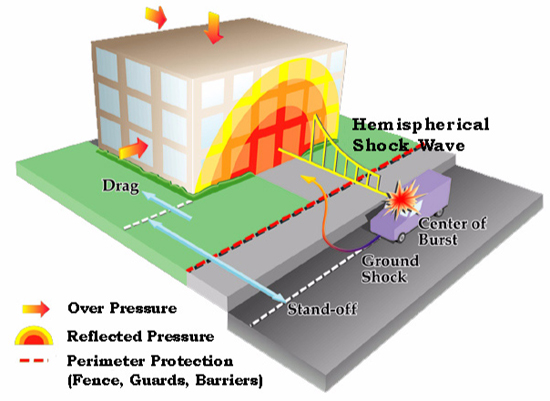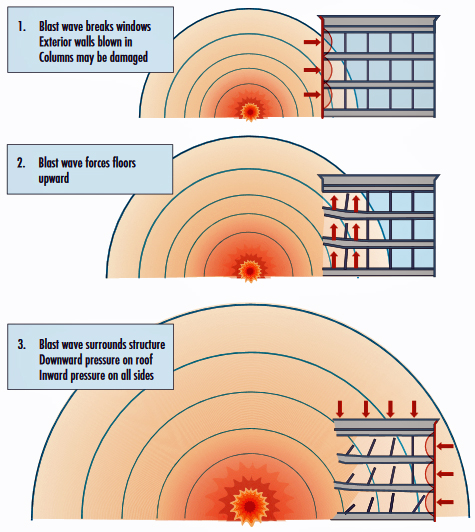Table of Contents
Introduction
Design serves many different purposes in in structural aspects and for buildings. As society becomes more complicated, there are more factors that have to be considered when faced with unexpected scenarios. One of the concerns that have to be addressed for more buildings that is on the rise is prevention and protection against explosions, especially for government and military based buildings. Since terrorist attack cases have increased dramatically over the last few years, they are considered dynamic loads along with natural disasters like seismic design for earthquakes and require meticulous consideration and calculation [1]. Designing for Blast means incorporating the possibility for an explosion has become a primary objective for the scope of the building and requires a series of various steps and impacts to be addressed before any decisions can be made. Although protection of people within the building would be the main concern, there are numerous other trade-offs and criteria that have to be assessed to be able to conclude with the best design [2].
Building after explosion [3] |
|---|
Purpose
Threat
For terrorist activities, usually the two main considerations are for vehicles and weapons [2]. In terms of watching out for vehicles, the potential threat emerges from all sides of a building that is parallel to or facing a street. The vehicle is considered an air-blast load and decreases with distance so the primary danger is near the base of the building. For prevention of vehicle attacks apart from screening are intrusions such as anti-ram barriers along the perimeter of the building as well as utilizing the form of the landscape to create an obstacle course can be effective. However, oftentimes the vehicle itself is not the only threat because they can be used as a diversion or container for a secondary attack such as an explosive or hand-held weapons like a gun so further protection is needed.
There are a multitude of various weapons that produce a hazard to the lives of people but in regards to a building, the greatest pressure comes from explosives. Factors to be aware of are that the impact of explosives decrease very quickly with time and space and usually the pressure produced increases linearly with the size. Although the actual explosion only lasts a couple milliseconds, the area of the shock wave can hit the entire building and even the surroundings.
Effects of an explosion:
- The side of the building facing the initial source can be amplified up to ten times the pressure.
- Has a positive pressure phase and a negative pressure phase.
- During the negative pressure phase, regions with low pressure such as windows and sloped roofs to fail and collapse.
- Thin members like columns are impacted more by drag effects than direct pressure.
- Rebound is structures moving in the reverse direction due to vibration and can cause the exterior envelope to fall.
- Below the point of impact, an underground crater will form that damages the foundation and anything below grade.
- Any energy of the weapon that transfers through soil will create a small earthquake that can derange mechanical and electrical systems.
Vehicle weapon threat [2] |
|---|
Sequence of air-blast effects [2] |
|---|
Building Damage
Damage done to a building can be separated into two categories of direct air-blast and progressive collapse [2]. Direct air-blast refers to the source of the explosion and takes into account the damage caused by the high-intensity pressures near the incident. In some cases, this may cause the exterior envelope to collapse in a specific area. How severe the damage ends up being is dependent on the weapon size, distance from the building envelope, and what materials it is made of.
After the initial failure in a localized area, the extent of the damage spreads out to further elements, called progressive collapse. This may propagate laterally outwards or even vertically upwards and downwards. Not all buildings face progressive collapse since this depends on the features of the building.
Design criteria to prevent progressive collapse:
- Indirect design: prescriptive design measures, two-way systems
- Direct load: design of individual structural members to take the load
- Alternate load path: Includes possibility of losing some members yet does not effect the stability of the building
Design criteria to prevent progressive collapse:
- Indirect design: prescriptive design measures, two-way systems
- Direct load: design of individual structural members to take the load
- Alternate load path: Includes possibility of losing some members yet does not effect the stability of the building
Structural Aspects and Specifications
Roof
Below Grade
Windows/Fenestration
- Use either laminated glass or apply anti-shatter film to glazing [4]
- Frame around window should exceed capacity of glazing, known as "glass fail first criteria"
- Designed to first resist conventional loads, then for explosive loads/ balance [2]
- Typically the weakest part of a building, balanced design means it does not lose to frames and wall systems
- Minimize number and size of windows
- For new construction, use laminated annealed glass with structural sealant
- Glass can break and retained by frame or only falls within 3-10 feet from the frame
Table 1. Performance Conditions for Windows [2]
| 1 | Safe | None | Glazing does not break. No visible damage to glazing or frame. |
|---|---|---|---|
| 2 | Very High | None | Glazing cracks but is retained by the frame. Dusting or very small fragments near sill or on floor acceptable. |
| 3a | High | Very Low | Glass cracks. Fragments enter space and land on floor no further than 1 meter (3.3 feet) from window. |
| 3b | High | Low | Glazing cracks. Fragments enter space and land on floor no further than 3 meters (10 feet) from the window. |
| 4 | Medium | Medium | Glazing cracks. Fragments enter space and land on floor and impact a vertical witness panel at a distance of no more than 3 m (10 feet) from the window at a height no greater than 2 feet above the floor. |
| 5 | Low | High | Glazing cracks and window system fails catastrophically. Fragments enter space impacting a vertical witness panel at a distance of no more than 3 meters (10 feet) from the window at a height greater than 0.6 meters (2 feet) above the floor. |
Building Materials and Methods
Issues and Considerations
Additional Reading and Resources
Contributors:
User Last Update Former user (Deleted) 1305 days ago Former user (Deleted) 1306 days ago Former user (Deleted) 1307 days ago



